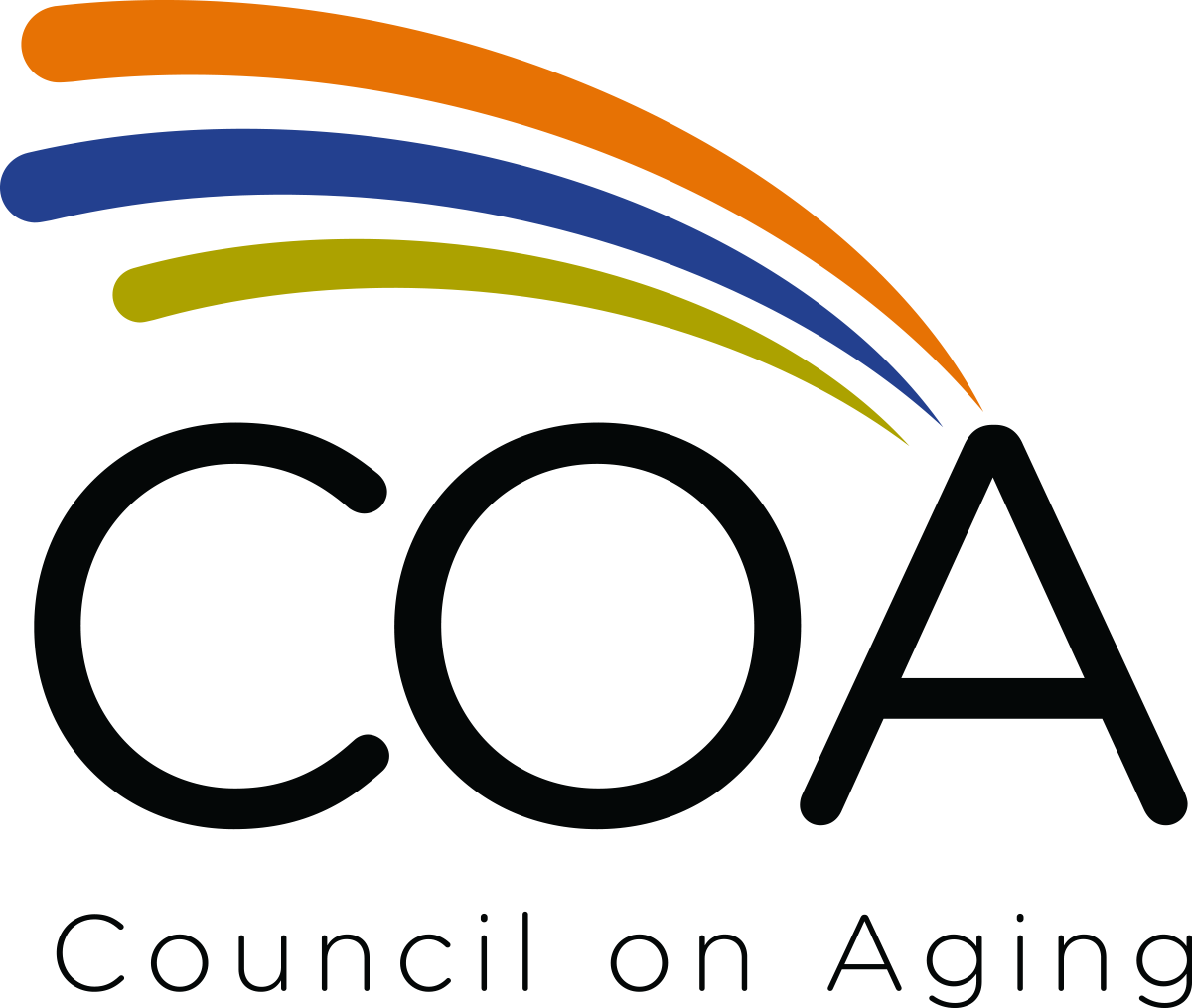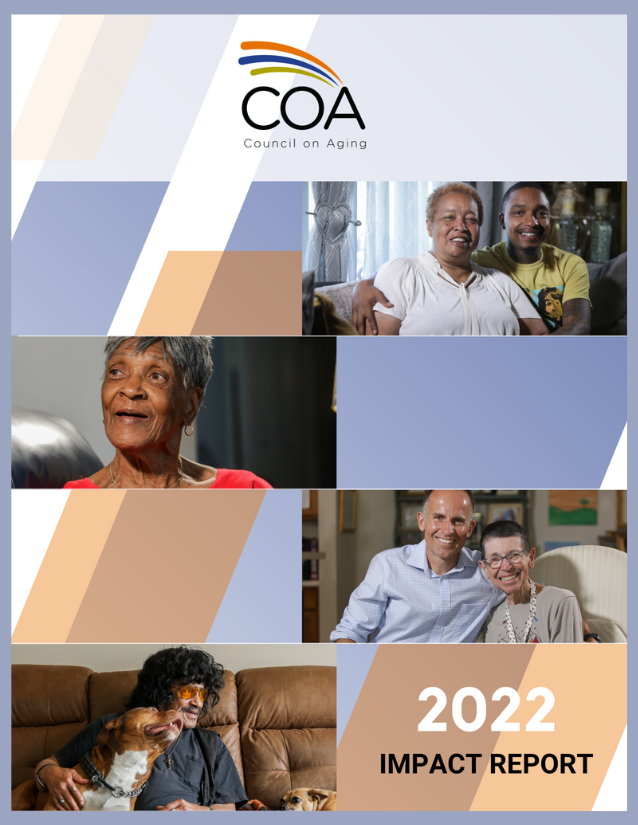Below are the full stories from Council on Aging’s 2022 Impact Report. Click the links below to jump directly to the article you wish to read.
- As workforce shortage continues, Area Agencies on Aging advocate for higher Medicaid reimbursement rates
- Harnessing technology to meet the needs of older adults and caregivers
- Innovative transportation service grows ridership and provider network in 2022
- COA adopts creative solutions to meet common needs of older adults
- Congregate meal program adapts to changing needs
- Voters pass senior services levies in two counties
- Innovative Council on Aging solution aims to expand the critical homecare workforce
- A positive attitude and reliable ride help cancer patient on her road to recovery
- COA uses virtual reality to support family caregivers
- 2022 a big year for recognition of COA innovation
As workforce shortage continues, Area Agencies on Aging advocate for higher Medicaid reimbursement rates
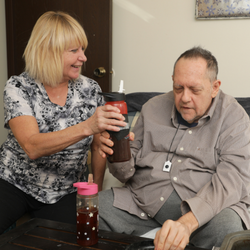
For several years – even before the start of the pandemic – organizations like Council on Aging that provide home and community-based long-term care services to older adults have been coping with a shortage of home health aides.
These critical workers provide very personal care, enabling older adults to remain safe and independent in their homes. They also help fill in gaps in care for family caregivers who are juggling multiple responsibilities, including young families and careers.
Older adults, caregivers and the network of service providers who rely on this critical workforce are suffering. Older adults experience long delays and inconsistencies with their care – or go without. Family caregivers are pulled from other responsibilities to provide care. Home health agencies that hire these workers and then contract with Council on Aging to deliver in-home services to eligible older adults are unable to find the staff needed to meet the demand. Some have shut down permanently.
Home health aides are part of a larger cohort of workers known as direct care workers. There are approximately 154,000 direct care workers in Ohio, over 60 percent of which provide home care services. Between 2020 and 2030, Ohio will have 230,000 vacant direct care positions to fill. During the same time period, Ohio’s 85 and older population (those most likely to need care) will grow 52 percent. (PHI, Scripps Gerontology Center at Miami University)
What’s behind this problem?
There are many contributing factors, but the biggest is wages. Other issues include limited benefits; occupational health risks (physical and emotional); few career advancement or development opportunities; and unstable and inflexible schedules.
Direct care workers, including home health aides, have left their jobs in search of stability, higher wages and opportunities for advancement. These obstacles are also what have kept new workers away.
- $21,000 median earnings per year – average hourly rate of $12/hour
- 48% live in or near poverty
- 32% lack available housing
- 88% are women
- 41% are people of color
- 11% are uninsured
(Source: PHI National)
What’s the solution?
Home health aides deserve a wage equal to the important role they play in our long-term care system. They provide very personal care – help with bathing, dressing and eating – as well as assistance with important everyday tasks like cleaning, cooking and running errands. Without this support, older adults are at greater risk for illness and injury, increased social isolation, and loss of independence.
In Ohio (and many other states), wages are directly connected to Medicaid reimbursement rates. Lawmakers determine these rates and put them into law during each state budget cycle. The low reimbursement rates paid to agencies that hire home health aides forces wages down and sends these workers to other sectors of the economy where they can make more money.
Advocacy is needed to ensure reimbursement rates are set at levels that can support a respectable wage for the home health aide workforce.
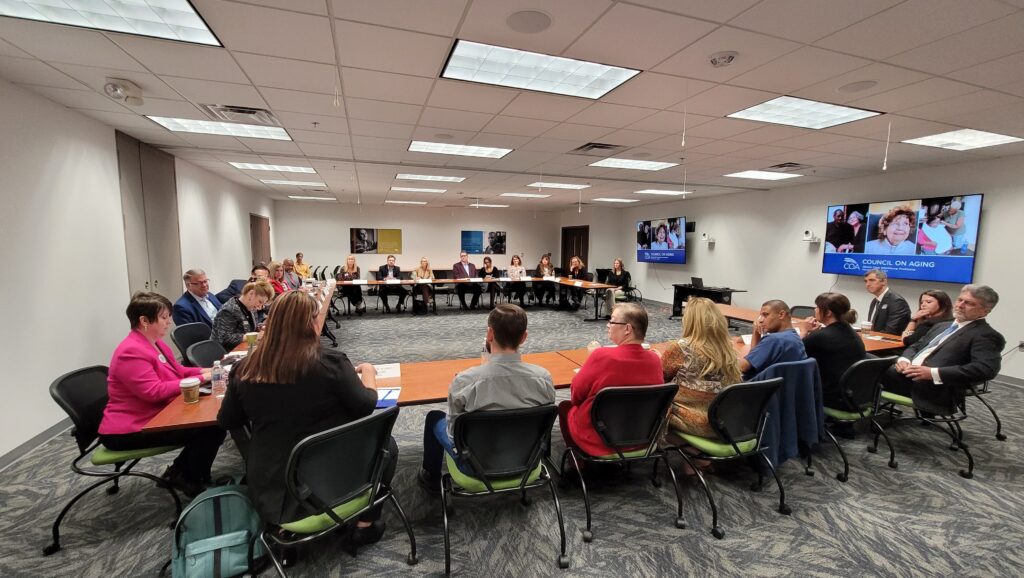
Ohio’s network of Area Agencies on Aging (AAA), including COA, have already begun this work. In 2022, COA and other AAAs hosted roundtables with elected officials to let them hear firsthand from people directly impacted by the home health aide shortage, including home health agencies, family caregivers, older adults, and home health aides themselves.
The message was clear: home health aides deserve higher, competitive wages and state-managed home and community-based care programs should be reviewed to remove rules and requirements that drive up costs without improving outcomes for individuals enrolled in the programs.
Ohio’s AAAs are asking lawmakers for a 50 percent increase in the Medicaid provider reimbursement rate, which would allow for a $20 per hour wage for the critical home health aide workforce. The next opportunity to change the reimbursement rates comes with the passage of Ohio’s 2024 budget.
In addition to advocacy, Council on Aging has been working to find innovative solutions to the workforce shortage, including:
- offering additional support and training to family caregivers
- using non-traditional providers to deliver services, such as laundry services
- using technology to expand opportunities for older adults and families to find and hire their own home care workers
To acknowledge the important care provided by home health aides, COA partnered with its service provider network to create the Service Excellence Awards. The awards recognize direct care workers employed within COA’s service provider network who provide superior care for our region’s older adults. Yearly, all award nominations are reviewed and considered for Council on Aging’s Hero Awards. Up to three Hero Awards are given each year. The award includes a cash prize. In 2022, Brett Syph, May Little and Candace Morris were recognized as Home Health Aide Heroes.
COA will continue to work with its service provider network, legislators and others to bring recognition to this critical workforce.
Harnessing technology to meet the needs of older adults and caregivers
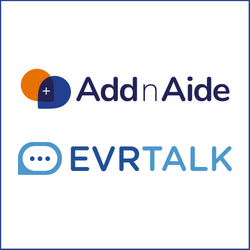
AddnAide
Developed by Council on Aging’s subsidiary, home52, AddnAide is an app that helps older adults who need care connect with those willing to provide it. The AddnAide app helps address the critical direct care worker shortage by tapping the efficiency of technology and the connectivity of social media.
AddnAide is accessible via the Google Play Store, Apple App Store or at addnaide.home52.org. It’s an enhancement of the consumer-directed care model, offering a secure space where older adults who need in-home care can match with available aides and then easily manage all aspects of their care needs – from scheduling appointments and approving time cards, to communicating with all members of the care team.
AddnAide launched during the summer as pilot in the Elderly Services Program in Hamilton and Warren counties. The launch included a marketing campaign designed to attract new and non-traditional workers to the workforce. The pilot phase of the launch has led to learning opportunities and enhancements to the AddnAide app, including improvements to speed up the onboarding process for aides and development of users’ guides and in-home tech support to help older adults get the most out of the app.
Click here to read about an aide’s experience using AddnAide.
Click here for more information and expect to hear more about AddnAide in the future.
EVRTalk
To provide support to the growing number of family members being called upon to provide care for aging loved ones, Council on Aging and its partner, the Live Well Collaborative, developed EVRTalk, a virtual reality experience designed to help caregivers feel more comfortable with their role and improve the caregiving experience for everyone.
EVRTalk presents caregiving situations from both the caregiver’s and the care recipient’s points of view, helping to encourage empathy and understanding of what older adults may experience when being cared for. It provides a safe environment for caregivers to learn and develop skills, without the fear of making a mistake. EVRTalk can be used in a variety of settings, including one-on-one with caregivers, in support groups, and as a training tool for people who work with or on behalf of older adults and caregivers. Click here to learn more about how EVRTalk works, and click here to learn about Council on Aging’s plans for EVRTalk.
Innovative transportation service grows ridership and provider network in 2022
Council on Aging (COA) has long sought a way to improve transportation services for older adults and people with disabilities in the region. Census data and research show a growing population of older and disabled adults and a lack of confidence in the region’s transportation infrastructure to meet the growing need.
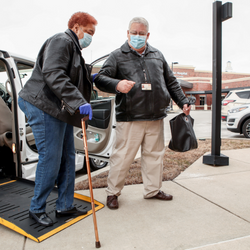
Existing regional transportation networks, including rideshare and public transit, do not always meet the transportation needs of older adults and individuals with disabilities. And while COA was already managing a network of transportation providers to meet the needs of program clients, the system did not allow for coordination or network optimization among providers.
COA’s vision for transportation included a centralized call center and a network of providers ready to meet the unique needs of older adult riders. After receiving a grant from the Federal Transit Administration (FTA) in 2019, Council on Aging began working on a plan to create a transportation coordination system.
In May 2021, Council on Aging and its subsidiary, home52, launched home52 Transportation. home52 Transportation coordinates multiple transportation providers through a centralized transportation coordination center, providing on-demand and advance-scheduled trips for riders who require specialized transportation services. The goal of home52 Transportation is to provide the right type of vehicle, at the right time, with the right support to meet an individual’s needs.
“The individuals who ride with us need hands-on support,” said program manager, Bryan Black. “They need someone to collect them at their door, assist them safely into and out of the vehicle, and then to assist them into their appointment location. In many cases, our drivers are also managing the rider’s equipment, such as walkers, canes and wheelchairs.”
In its launch year, the program provided more than 8,600 trips and played an important role in helping older adults get to COVID-19 vaccination appointments. In its first full year of operation, home52 Transportation provided nearly 40,000 rides for approximately 1,200 riders in Hamilton County.
The home52 Transportation team includes 11 coordination center employees who perform a variety of functions for riders and transportation providers:
- Coordinate with riders and providers to schedule the most appropriate mode of transportation to meet the rider’s needs.
- Communicate with riders and providers during the life cycle of the ride.
- Resolve issues that might arise with rides, including mitigation of late rides (to ensure riders can keep their appointments even if their ride is running late).
- Identify and report ridership trends that may result in adverse health outcomes.
Since the program’s launch, the number of transportation providers engaged with home52 Transportation has tripled. Today, coordination center staff work with 16 local providers to schedule rides, including eight small business entities. Black said his staff worked hard to recruit additional providers with a particular focus on small and minority-owned businesses. Provider growth occurred largely through good service and word of mouth.
“home52 presents a good opportunity for small businesses because there is very little administrative overhead for the provider,” Black explained. “They don’t need office staff or scheduling software. We manage all of that. All we ask of the providers is that they provide a good driver, a good vehicle and a high level of customer service for our riders.”
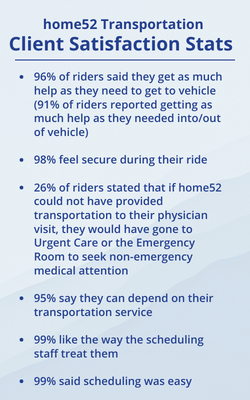
In fact, riders are regularly surveyed to track satisfaction levels in the program. More than 96 percent of riders surveyed rated the quality of the coordination center as above average or excellent with more than 95 percent of riders stating they can depend on their transportation service. And, nearly 90 percent of riders said they believed access to home52 Transportation helped improve their health.
home52 Transportation has sought out community partnerships that support the program’s growth, in terms of both funding and ridership. For example, the program received a large grant from the OKI Regional Council of Governments. According to Black, the partnership with OKI is important not just because of the funding for rides, but also because it gives home52 and Council on Aging access to the region’s transportation planners and the opportunity to advocate for the needs of older adults and people with disabilities.
Other funding sources in 2022 included the Hamilton County Elderly Services Program and grants from the City of Cincinnati, and the Duke Energy Foundation.
The program expanded ridership in other ways during 2022, including becoming certified by the Ohio Department of Developmental Disabilities to provide non-medical transportation for individuals enrolled in Medicaid Waiver programs to travel to workshops, day programs and supported employment. Additionally, hospitals and medical providers use home52 Transportation to transport patients to their outpatient facilities for routine medical appointments. And, a self-pay (private pay) option launched in June 2022 which allows older adults to schedule rides anywhere they need to go within Council on Aging’s service area. Self-pay rates are based on mileage and the type of vehicle required to meet the rider’s needs.
Currently, home52 Transportation is available in Hamilton County with plans to expand into additional counties in Council on Aging’s service area in 2024.
COA adopts creative solutions to meet common needs of older adults

Because they are administered at the local level, the tax-levy-funded Elderly Services Programs (ESP) have served as incubators for innovative solutions to meet the ever-changing needs of our region’s older adults.
Many older adults enrolled in ESP need assistance with everyday household tasks, including laundry and light cleaning. Traditionally, these needs have been met by home health aides employed through home health agencies. Because of the aide shortage, COA clients are experiencing disruptions in these and other common services.
To get around this, Council on Aging has sought innovative ways to help ESP clients get the assistance they need. For example, clients who need help with laundry can now choose to use a laundry service, instead of waiting for an aide to become available. In ESP, laundry assistance is part of a larger bundle of services known as home care assistance. Breaking this individual service out to be provided on its own and in a different way expands ESP’s ability to serve older adults who have been waiting for a home health aide to provide this service.
The service picks up dirty laundry and linens and returns them clean and folded. Clients have a range of detergents to choose from and can receive text and email reminders about their service. COA is currently offering the laundry service to ESP clients in Hamilton and Warren counties, and in a limited capacity in Butler County. So far, more than 90 clients have opted to try the service. COA is currently working to identify a laundry provider in Clinton County.
Another service traditionally bundled in home care assistance and impacted by the home health aide shortage is housekeeping. To meet this need, COA expanded the equipment available through ESP’s Durable Medical Equipment service to include adaptive cleaning supplies such as lightweight cordless mops and vacuums, and laundry carts.
For clients who are physically able and prefer to do light housekeeping on their own, the equipment helps them meet a daily need, while also gaining a sense of independence. This service launched in May with 136 clients receiving the adaptive cleaning equipment through the end of the fiscal year. Clients report a high level of satisfaction with the equipment, saying it has enabled them to perform light housekeeping duties around their home while they wait for a home health aide.
Congregate meal program adapts to changing needs
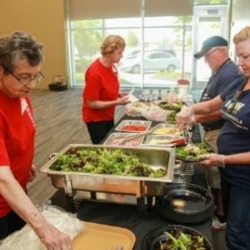
Congregate meals have been an integral part of the Older Americans Act Senior Nutrition Program for more than 50 years. During this time, the meal program has adapted to meet the changing needs of the older adults who rely on it to meet their nutritional – and social – needs.
Historically, many senior centers have served as congregate meal sites. But in recent years, senior center closures have left many older adults searching for new places to socialize and enjoy a meal.
That’s what happened to members of the West Chester Senior Coalition when their local senior center closed in 2019. Council on Aging connected the group to the MidPointe Library West Chester, and since January 2022, they’ve been meeting there on Fridays to play cards, enjoy each other’s company and share a meal.
The meal is provided as part of Council on Aging’s (COA) congregate meal program, funded by the Older Americans Act. As the Area Agency on Aging (AAA) for southwestern Ohio, including Butler County, COA plans and oversees community services funded by the Older Americans Act, including congregate meals.
“Food and fellowship often go hand in hand,” said Ken Wilson, COA’s vice president of program operations “Congregate meals provide both – they help older adults get the nutrition they need to live healthy lives, while also providing an opportunity to socialize with friends and neighbors.”
In 2022, COA provided 1.6 million meals in five counties.
Click here to read more about the congregate meal at the MidPointe Library.
Voters continue strong support of county senior services levies
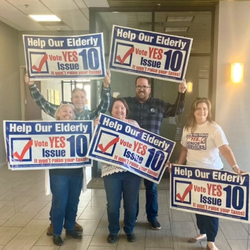
As we age, most of us would like to stay in our own homes for as long as possible. But, when it comes to accessing programs and services to support independent living, where you live really does matter. For example, more than 80 percent of counties in Ohio have tax levies that provide some type of service or support to older adults, including all five counties in Council on Aging’s (COA) service area.
The levies in COA’s service area are unique in that they provide a funding stream dedicated to helping older adults age in place through services such as home-delivered meals, transportation, help with housekeeping and personal care assistance. These programs – known as the Elderly Services Program – serve older adults who might otherwise find themselves caught in the middle – with too many assets to qualify for Medicaid-funded programs, and too little to afford private care.
The levy-funded programs managed by Council on Aging in Butler, Clinton, Hamilton and Warren counties (a similar program in Clermont County is managed by Clermont Senior Services) served more than 15,000 older adults in 2022. That’s more than 57 percent of all individuals served by COA in 2022.
These programs provide a critical safety net for some of the most vulnerable members of our community and they would not be possible without the generous support of local taxpayers and voters. In fact, during fiscal year 2022, senior services levies passed by wide margins in Warren, Clinton and Hamilton counties (Butler County’s most recent levy passed in 2020).
Voters in our region have been approving senior services levies for more than 30 years. They recognize two important facts about these levies: 1) they are compassionate in that they help older adults remain safe and independent in their homes and communities, and 2) they cost taxpayers a fraction of the cost of similar care provided in an institutional setting.
As administrator of these levy dollars, Council on Aging will continue to strive to provide the highest quality services at the lowest cost in order to serve as many people as possible with the tax dollars available.
Innovative Council on Aging solution aims to expand the critical homecare workforce
Michelle was looking for flexible work when a church friend referred her to AddnAide. She’d been cleaning houses since high school and had experience providing care for older family members, in addition to raising her four young children. It seemed like a good fit.

And it was. Michelle signed up for AddnAide in December 2022 and has been providing care for a handful of older adults in Hamilton and Warren counties who need in-home help.
AddnAide was developed by Council on Aging (COA) and its subsidiary, home52, to help overcome challenges created by a national shortage of traditional homecare workers. Because of this shortage, older adults across southwestern Ohio need help with household tasks such as laundry, housekeeping, meal preparation, errands and more to remain in their homes.
While the problem is not unique to southwestern Ohio, AddnAide is a unique and innovative solution to the problem.
AddnAide allows older adults who need and qualify for in-home care services to connect with people, like Michelle, who are willing to provide that care. No experience is required for potential caregivers to sign up for AddnAide. It’s ideal for those seeking a flexible schedule, such as stay-at-home parents, retirees, those with other employment, or students. It’s also ideal for community-minded individuals who want to give back while supplementing their income. To create an AddnAide account, caregivers must be 18 years old, have transportation and complete a required background check.
AddnAide expands the consumer-directed model of care, in which older adults can hire their own caregivers instead of using a traditional home health agency. The traditional model of consumer-directed care works well for older adults who know someone within their personal network who can provide their care. However, this model excludes many older adults who have limited social circles. AddnAide is attracting new individuals – from a variety of backgrounds – to this critical workforce and expanding the pool of caregivers older adults can choose from to meet their needs.
For Michelle, AddnAide’s flexibility makes all the difference. A busy mom who also helps with the family cleaning business, she needed a job that would allow her to create her own schedule.
“It’s been very good because I can make my own schedule,” she said. “I can choose what days I work and create a schedule that works for my life.”
Michelle said signing up in AddnAide was easy. After she created her account, she received information regarding how to complete the required background check. With the background check complete, Michelle’s profile became visible to older adults in the app. Michelle also has the ability to “wave” to older adults in AddnAide to let them know she is available to provide care. She receives a steady stream of employment inquiries and she is able to choose who she works with based on her skills, the older adult’s needs, and other factors including schedules and driving distance.
In AddnAide, older adults (or their designee) act as employers for their hired caregiver(s). AddnAide makes it easy to manage the employee-employer relationship, including scheduling appointments, approving timecards and getting paid. Everything is built into the AddnAide app and a third-party provider manages all payroll and tax-related aspects of the employment relationship.
Communication is another key feature of AddnAide. For example, Michelle can easily communicate with her clients if she’s running late or needs to make schedule adjustments. She can also communicate with other members of her clients’ care teams.
Older adults who use AddnAide have a care manager who determines what services they need and how many hours of care they can receive. The AddnAide app provides safeguards to ensure older adults receive only the care they are authorized to receive, in the correct amount, and at the right time.
Most older adults in AddnAide need help with basic activities of daily living. Michelle helps her clients with cleaning and dusting, meal preparation and cooking, laundry, taking out the trash, and running errands such as grocery shopping, picking up prescriptions or going to the library. These are critical services that make all the difference for older adults who need help and want to remain independent in their homes.
Michelle’s professional cleaning experience is something her clients appreciate. “[Cleaning] is something I know how to do; I have experience,” she said. “My clients want things done a certain way and they appreciate my work.”
“I have a good relationship with my clients,” Michelle said, adding that many of her clients appreciate her Hispanic heritage and the opportunity to be exposed to new ways of doing things. “Clients ask me to cook for them, and I show them the way I was taught to cook. They really like it!”
A positive attitude and reliable ride help cancer patient on her road to recovery
Battling cancer for a number of years and no longer able to drive to her appointments, Mary called Council on Aging for assistance.
Today, Mary is enrolled in the Hamilton County Elderly Service Program and receives transportation to her chemotherapy treatments. Her rides are coordinated through home52 Transportation.
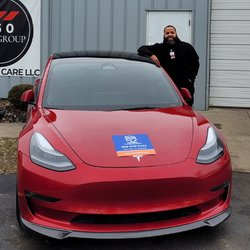
home52 Transportation coordinates multiple transportation providers through a centralized transportation coordination center, providing on-demand and advance-scheduled trips for riders, like Mary, who require specialized transportation services. home52 Transportation was created by Council on Aging and its subsidiary, home52. It launched in May 2021.
When Mary needs to schedule a ride, she calls home52 Transportation’s call center. “Everyone is delightful and helpful,” Mary said of the call center staff. “The day before my appointment, I receive a reminder call. This is beneficial. I like to have my clothes laid out the night before and pack a lunch. My treatment lasts all day.”
On appointment days, Mary receives a call to let her know her ride is on the way. “This provides the time I need to grab my lunch, head to the garage and position myself in the wheelchair,” she explained.
If a ride is running late, coordinators in the home52 Transportation call center reach out to clients to let them know. If the client is going to an appointment and will be late because of a transportation delay, call center staff reach out on the client’s behalf to ensure they will still be seen at their appointment when they arrive.
Most of Mary’s rides to her chemotherapy appointments have been provided by home52 Transportation provider, 360 Total Care. Rodger is one of her regular drivers. “He is a delight and I enjoy our conversations,” said Mary, adding that her ride is always on time. She is especially grateful when it’s Rodger who returns to pick her up when her treatments are finished.
home52 Transportation is different than other transportation systems, including public transit and rideshare services. These traditional systems do not always meet the transportation needs of older adults and individuals with disabilities.
“The individuals who ride with us need hands-on support,” said home52 Transportation program manager, Bryan Black. “They need someone to collect them at their door, assist them safely into and out of the vehicle, and then to assist them into their appointment location. In many cases, our drivers are also managing the rider’s equipment, such as walkers, canes and wheelchairs.”
This is what makes the difference for Mary, especially after a long day of treatment. “I have a smile on my face when I see Rodger return to pick me up,” she said. “At my home, Rodger opens the garage door and wheels me in. He knows I’m very weak. He stands behind me, provides an arm so that I may lift myself up from the wheelchair, and he’s right there when I step into my home.”
Exhausted from her treatment, Mary can often be heard singing Amazing Grace or chanting as she makes the short trip from her garage into her home. She said, “This provides the motivation I need to place one foot in front of the other.”
As Mary’s needs have changed over the years, her Elderly Services Program care manager, Deanna, has helped, ensuring Mary has the support she needs so she doesn’t miss a treatment. And, Mary’s treatments are working. She recently reported to Deanna that her numbers have improved dramatically in the last year. “Thank goodness,” she told Deanna. “COA got me there. Thank you for the support and mostly the transportation.”
Read more about home52 Transportation.
COA uses virtual reality to support family caregivers
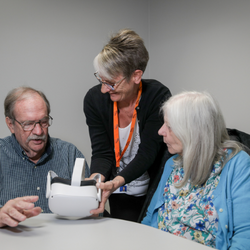
When Kathy began losing her way while driving to familiar locations, her husband, Dave, knew something was going on. Kathy was diagnosed with Alzheimer’s disease in 2019.
Days spent living with and caring for an Alzheimer’s patient are many times filled with tears and frustration, and Dave’s experience has been no different. Their adult children live out of state, and even with the help of Kathy’s sisters, Dave shoulders much of the responsibility for Kathy’s care. “Nobody is prepared for this,” he said.
EVRTalk, a virtual reality caregiver experience developed by Council on Aging in partnership with the Live Well Collaborative, is helping caregivers like Dave navigate the caregiving journey. EVRTalk uses Virtual Reality (VR) to help family caregivers feel more comfortable with their role. By wearing a headset, participants are immersed in a complete environment that uses digital conversations and graphics to help users experience several common caregiving scenarios.
During these common caregiving situations, participants can make decisions about the best course of action to take, without the fear or pressure of making the wrong choice. They then discover the positive or negative impact of those choices and learn how different choices could have resulted in alternative outcomes.
“I don’t consider myself a techie, but I know that when used properly, technology can be helpful in making sure needs are met. EVRTalk is very easy to understand and work through,” Dave said.
One of the EVRTalk scenarios Dave is looking forward to trying focuses on learning medication management. “At a recent doctor visit, it was evident that Kathy was confused about taking her medications,” Dave recalled. “The doctor is reluctant to even prescribe the necessary medications without knowing they will be used properly.”
In the medication scenario, caregivers like Dave can witness common conversations that occur between older adults and their caregivers around the proper use and dispensing of medications. They watch and learn as a caregiver’s response to an older adult’s hesitation or confusion about medication results in specific outcomes.
Other EVRTalk scenarios include conversations on incontinence, talking down hallucinations, identifying caregiver burnout, and talking about end-of-life wishes.
Feedback about EVRTalk has been positive and has reinforced that this type of experience works for busy caregivers who don’t have time for lengthy training sessions.
Among people who’ve tested EVRTalk, 91 percent of people said EVRTalk is useful compared to other caregiver trainings currently available and 95 percent agreed EVRTalk increased their awareness about the challenges faced by older adults. Additionally, everyone who tested EVRTalk said they felt fully engaged when they were in the scenarios.
For Dave, EVRTalk is one tool he can use on what’s sure to be a long caregiving journey.
“I didn’t realize there wasn’t a cure [for Alzheimer’s],” he said. “And I know it’s harder for her than it is for me.”
According to Kathy, that may or may not be true. “I know it’s frustrating for him to have to repeat,” she said. “I have to laugh at myself, otherwise, I’ll cry.”
Click here to learn more about EVRTalk.
2022 a big year for recognition of COA innovation
Council on Aging (COA) and its team members were recognized for their work during the 2022 fiscal year by the following organizations:
The National Association of Social Workers Ohio Chapter named COA its 2021 Region 6 Agency of the Year. The award honors agencies that best exemplify social work values in the field, using best practices to make positive change in their communities. Read More
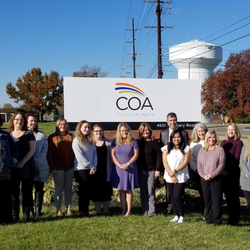
Interact for Health awarded a $6,500 Advised Grant to COA. The funds are playing a critical role in meeting the transportation needs of low-income older adults who do not qualify for other existing transportation programs.
Council on Aging received an Inspire Healthcare award from The Health Collaborative for Discharge to Home, a program developed by COA during the pandemic to provide a safe, supportive path home for older adults being discharged from area hospitals and nursing facilities, while also freeing up valuable healthcare resources. Inspire Healthcare is the region’s premier healthcare awards event, recognizing regional heroes who are pioneering efforts in improving health and healthcare. Read More
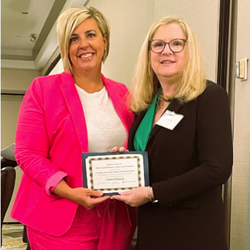
Medical Mutual and the Ohio Association for Area Agencies on Aging recognized COA’s Care Census with the 2022 Medical Mutual Aging and Disability Innovation Award. The Care Census program researched the scope and impact of caregiving responsibilities on the broader workforce and worked to build partnerships with the local business community to better support working caregivers. Read More
Council on Aging’s Vice President of Program Operations, Ken Wilson, was named Ohio Association of Gerontology and Education’s (OAGE) 2021 Practitioner of the Year. The award recognizes individuals and organizations that either have improved services to older adults through research and evaluation or have developed noteworthy partnerships with institutions of higher learning for the betterment of Ohio’s elders.

The Cincinnati Business Courier named Council on Aging Senior Innovation Designer Jai’La Nored to its Forty Under 40 Class of 2022. The annual awards program recognizes young leaders and professionals from across Greater Cincinnati. Read More
